Evaluation of Subsidy Programmes
This research group focuses on two main research questions: (i) What is the causal effect of cooperative innovation activities on the performance of firms and regions? (ii) What are the causal effects of public Research and Development (R&D) support schemes on the performance of firms and regions? The first research question concerns the dynamics of firms and regions as a result of their different innovation activities. We apply a micro-based integrative perspective on innovative activities which allows identifying causal effects of cooperative activities on specific outcomes (e. g., patent applications, scientific publications, employment growth, or productivity growth). Concerning the second research question, recent studies mainly focus on the evaluation of one specific subsidy scheme. Research in this group aims to overcome this shortcoming by considering various support schemes. Indicators for the firms’ success are (amongst others) patent applications and employment growth. The results allow insights for the future design of innovation support schemes.
Centre for Evidence-based Policy Advice (IWH-CEP)
Research Cluster
Economic Dynamics and StabilityYour contact

Mitglied - Department Präsidialbereich
EXTERNAL FUNDING
09.2019 ‐ 09.2022
Establishing Evidence-based Evaluation Methods for Subsidy Programmes in Germany (EVA-KULT)
European Regional Development Fund (ERDF)
The project aims at expanding the Centre for Evidence-based Policy Advice at the Halle Institute for Economic Research (IWH-CEP).
01.2018 ‐ 12.2020
Networked growth - Innovative Saxony-Anhalt through digital business models (Competence Center 4.0)
Federal Ministry for Economic Affairs and Energy (BMWI)
01.2017 ‐ 12.2018
Political Participation in Eastern Germany
Federal Ministry for Economic Affairs and Energy (BMWI)
12.2015 ‐ 11.2018
Socio-economic Effects of Research on Innovative Approaches for POC Diagnostics
Federal Ministry of Education and Research (BMBF)
Part of the EXASENS project. Coordinated by the Leibniz Institute of Photonic Technology (IPHT) in Jena, nine Leibniz institutes are working together on researching point-of-care (POC) technology for the prediction and diagnosis of chronic inflammatory respiratory diseases. See press release.
02.2017 ‐ 02.2018
The Importance of Non-University Research Institutions for the Development of Firms and Regions (Be_For_Reg-Projekt)
Federal Ministry of Education and Research (BMBF)
01.2015 ‐ 12.2016
Evaluation of the "Joint Task 'Improving the Regional Economic Structure'" in the Federal State of Saxony-Anhalt
Investitionsbank Sachsen-Anhalt
Refereed Publications
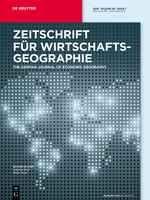
Drivers of the Spatial Emergence and Clustering of the Photovoltaic Industry in Germany
in: Zeitschrift für Wirtschaftsgeographie, No. 3, 2015
Abstract
The drivers of the spatial emergence and clustering of the photovoltaic industry in Germany. Following the relatedness literature, we explore to what extent related industries influenced the regional emergence of the photovoltaic (PV) industry. In addition, we shed light on factors explaining selective processes of clustering. We particularly argue that generic resources and resources of related activities have been crucial for the regional concentration in early phases of the industry life cycle. With increasing maturity, industry-specific resources became more important. Based on a unique dataset containing population dynamics of the German PV industry, the hypotheses are tested empirically. Our results partially confirm the assumed beneficial effects of related industries for the emergence of the PV industry. Moreover, we observe changes in the relative importance of factors supporting regional concentration, with industry-specific resources becoming dominant as the industry matures.
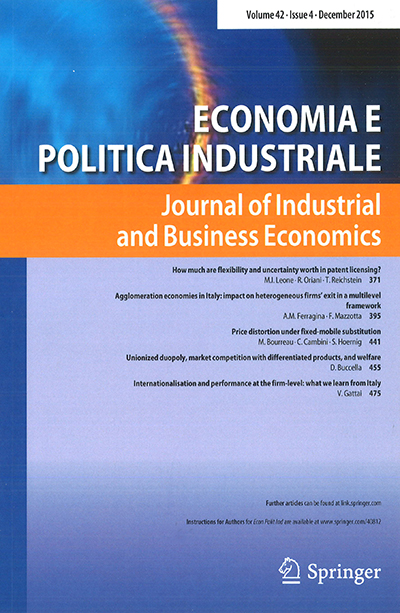
Determinants of Knowledge Exchange Between Foreign and Domestic Enterprises in European Post-transition Economies
in: Journal Economia e Politica Industriale (Journal of Industrial and Business Economics), No. 4, 2014
Abstract
The aim of this paper is to contribute to the literature on internationalised research and development by investigating determinants of knowledge and technology transfer between foreign subsidiaries and the local economy in European post-transition economies. This inquiry leads to a better understanding of determinants that influence this knowledge and technology exchange. Applying a logit model, we find that, in particular, the foreign subsidiary’s corporate governance structure, its embeddedness in the multinational enterprise’s internal knowledge base, its own technological capacity, the growth of the regional knowledge stock and the regional sectoral diversification are all positively associated with the transfer of knowledge. Subsidiaries’ investment motives and the relative weight of the sector of investment in the region’s economy appear to be of less importance. The analysis focuses on European post-transition economies, using the example of five selected Central Eastern European countries and East Germany. We exploit a unique dataset, the IWH FDI Micro database, which contains information on one thousand two hundred forty-five foreign subsidiaries in this region.
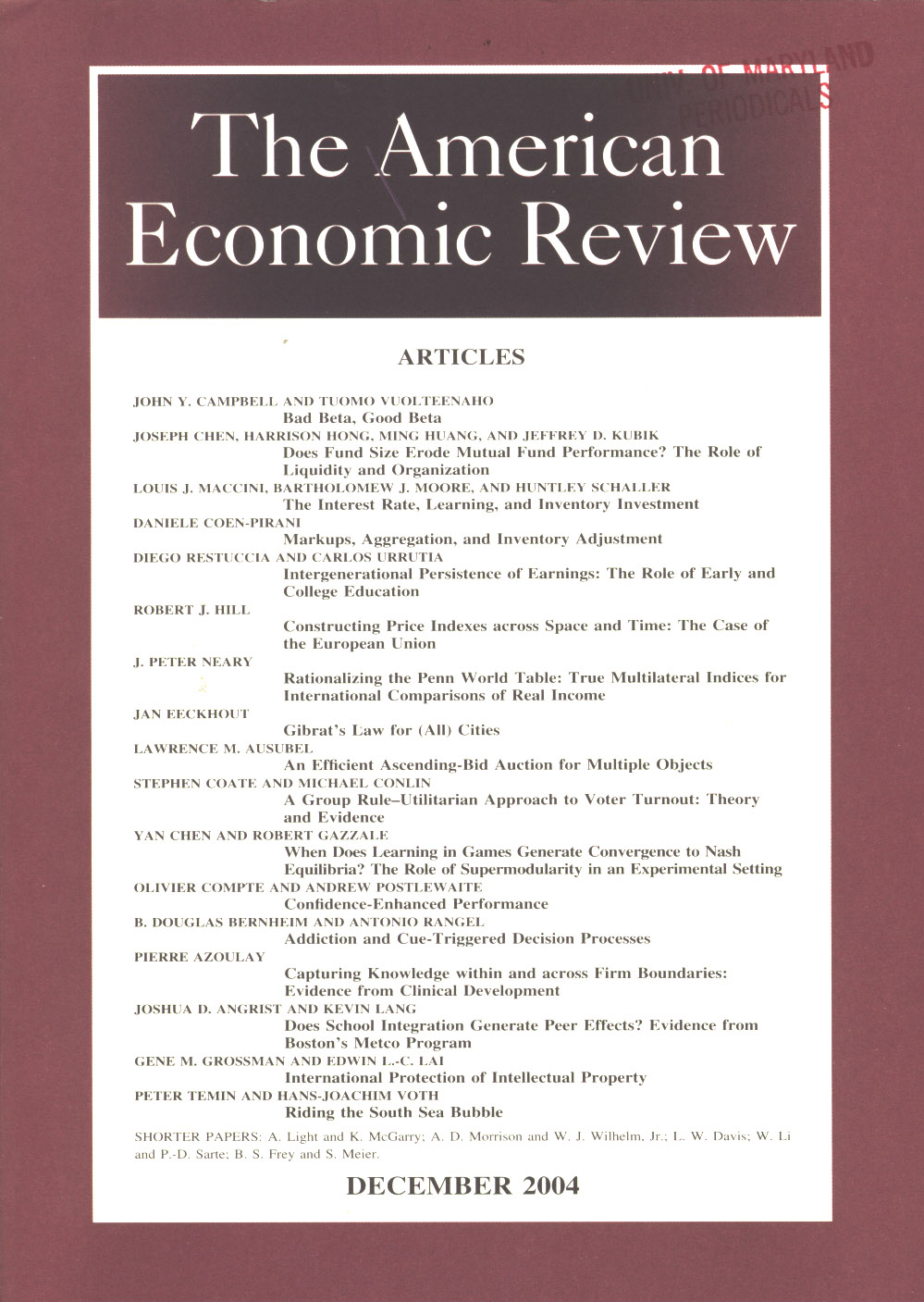
A Community College Instructor Like Me: Race and Ethnicity Interactions in the Classroom
in: American Economic Review, No. 8, 2014
Abstract
Administrative data from a large and diverse community college are used to examine if underrepresented minority students benefit from taking courses with underrepresented minority instructors. To identify racial interactions we estimate models that include both student and classroom fixed effects and focus on students with limited choice in courses. We find that the performance gap in terms of class dropout rates and grade performance between white and underrepresented minority students falls by 20 to 50 percent when taught by an underrepresented minority instructor. We also find these interactions affect longer term outcomes such as subsequent course selection, retention, and degree completion.
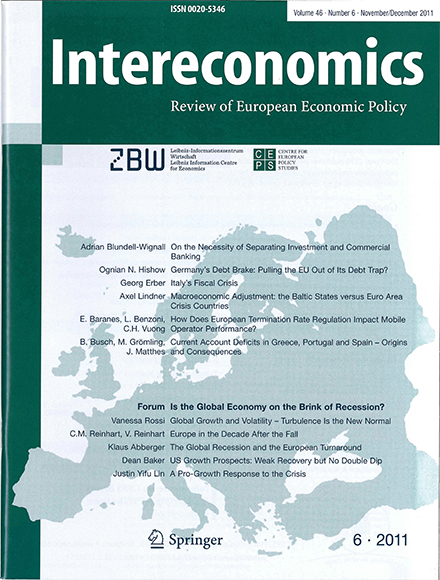
The Skills Balance in Germany’s Import Intensity of Exports: An Input-Output Analysis
in: Intereconomics, No. 2, 2014
Abstract
In the decade prior to the economic and financial crisis, Germany’s net exports increased in absolute terms as well as relative to the growing level of import intensity of domestically produced export goods and services. This article analyses the direct and indirect employment effects induced both by exports as well as by of the import intensity of the production process of export goods and services on the skills used. It shows that Germany’s export surpluses led to positive net employment effects. Although the volume of imports of intermediate goods increased and was augmented by the rise in exports, it could not undermine the overall positive employment effect.
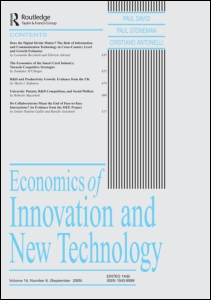
R&D Cooperation for Non-technological Innovations
in: Economics of Innovation and New Technology, No. 7, 2014
Abstract
Past research on the impact of R&D cooperation on firm innovation performance has almost solely focused on technological innovations. This paper investigates the impact of R&D cooperation on non-technological innovation performance of firms. In doing so, seven different cooperation partner types are distinguished. Survey data from German firms are used for the econometric analysis. It is shown that R&D cooperation increases the probability of a firm to introduce non-technological innovations. R&D cooperation with suppliers, consultants, other firms within the same firm group and universities has a significant positive impact on organizational and marketing innovation performance. Cooperation with governmental research institutes and competitors has no significant effect. R&D cooperation with customers has a significant impact on a firm's organizational innovation performance, but not on marketing innovation performance.
Working Papers

Do Manufacturing Firms Benefit from Services FDI? – Evidence from Six New EU Member States
in: IWH Discussion Papers, No. 5, 2015
Abstract
This paper focuses on the effect of foreign presence in the services sector on the productivity growth of downstream customers in the manufacturing sector in six EU new member countries in the course of their accession to the European Union. For this purpose, the analysis combines firm-level information, data on economic structures and annual national input-output tables. The findings suggest that services FDI may enhance productivity of manufacturing firms in Central and Eastern European (CEE) countries through vertical forward spillovers, and thereby contribute to their competitiveness. The consideration of firm characteristics shows that the magnitude of spillover effects depends on size, ownership structure, and initial productivity level of downstream firms as well as on the diverging technological intensity across sector on the supply and demand side. The results suggest that services FDI foster productivity of domestic rather than foreign controlled firms in the host economy. For the period between 2003 and 2008, the findings suggest that the increasing share of services provided by foreign affiliates enhanced the productivity growth of domestic firms in manufacturing by 0.16%. Furthermore, the firms’ absorptive capability and the size reduce the spillover effect of services FDI on the productivity of manufacturing firms. A sectoral distinction shows that firms at the end of the value chain experience a larger productivity growth through services FDI, whereas the aggregate positive effect seems to be driven by FDI in energy supply. This does not hold for science-based industries, which are spurred by foreign presence in knowledge-intensive business services.

Isolation and Innovation – Two Contradictory Concepts? Explorative Findings from the German Laser Industry
in: IWH Discussion Papers, No. 1, 2015
Abstract
We apply a network perspective and study the emergence of core-periphery (CP) structures in innovation networks to shed some light on the relationship between isolation and innovation. It has been frequently argued that a firm’s location in a densely interconnected network area improves its ability to access information and absorb technological knowledge. This, in turn, enables a firm to generate new products and services at a higher rate compared to less integrated competitors. However, the importance of peripheral positions for innovation processes is still a widely neglected issue in literature. Isolation may provide unique conditions that induce innovations which otherwise may never have been invented. Such innovations have the potential to lay the ground for a firm’s pathway towards the network core, where the industry’s established technological knowledge is assumed to be located. The aim of our paper is twofold. Firstly, we propose a new CP indicator and apply it to analyze the emergence of CP patterns in the German laser industry. We employ publicly funded Research and Development (R&D) cooperation project data over a period of more than two decades. Secondly, we explore the paths on which firms move from isolated positions towards the core (and vice versa). Our exploratory results open up a number of new research questions at the intersection between geography, economics and network research.

Does Proximity Matter in the Choice of Partners in Collaborative R&D Projects? – An Empirical Analysis of Granted Projects in Germany
in: IWH Discussion Papers, No. 12, 2014
Abstract
This paper contributes to the discussion on the importance of physical distance in the emergence of cross-region collaborative Research and Development (R&D) interactions. The proximity theory, and its extensions, is used as a theoretical framework. A spatial interaction model for count data was implemented for the empirical analysis of German data from the period from 2005 to 2010. The results show that all tested proximity measurements (geographical, cognitive, social and institutional proximity) have a significant positive influence on collaboration intensity. The proximity paradox, however, cannot be confirmed for geographical, social and institutional proximity, but for cognitive proximity.

Is Subsidizing Companies in Difficulties an Optimal Policy? An Empirical Study on the Effectiveness of State Aid in the European Union
in: IWH Discussion Papers, No. 9, 2014
Abstract
Even though state aid in order to rescue or restructure ailing companies is regularly granted by European governments, it is often controversially discussed. The aims for rescuing companies are manifold and vary from social, industrial and even political considerations. Well-known examples are Austrian Airlines (Austria) or MG Rover (Great Britain). Yet, this study aims to answer the question whether state aid is used effectively and whether the initial aim why aid has been paid has been reached, i.e. the survival of the company. By using data on rescued companies in the EU and applying a survival analysis, this paper investigates the survival rates of these companies up to 15 years after the aid has been paid. In addition, the results are compared to the survival rates of non-rescued companies which have also been in difficulties. The results suggest that despite the financial support, business failure is often only post-poned; best survival rates have firms with long-term restructuring, enterprises in Eastern Europe, smaller firms and mature companies. However, non-funded companies have an even higher ratio to go bankrupt.
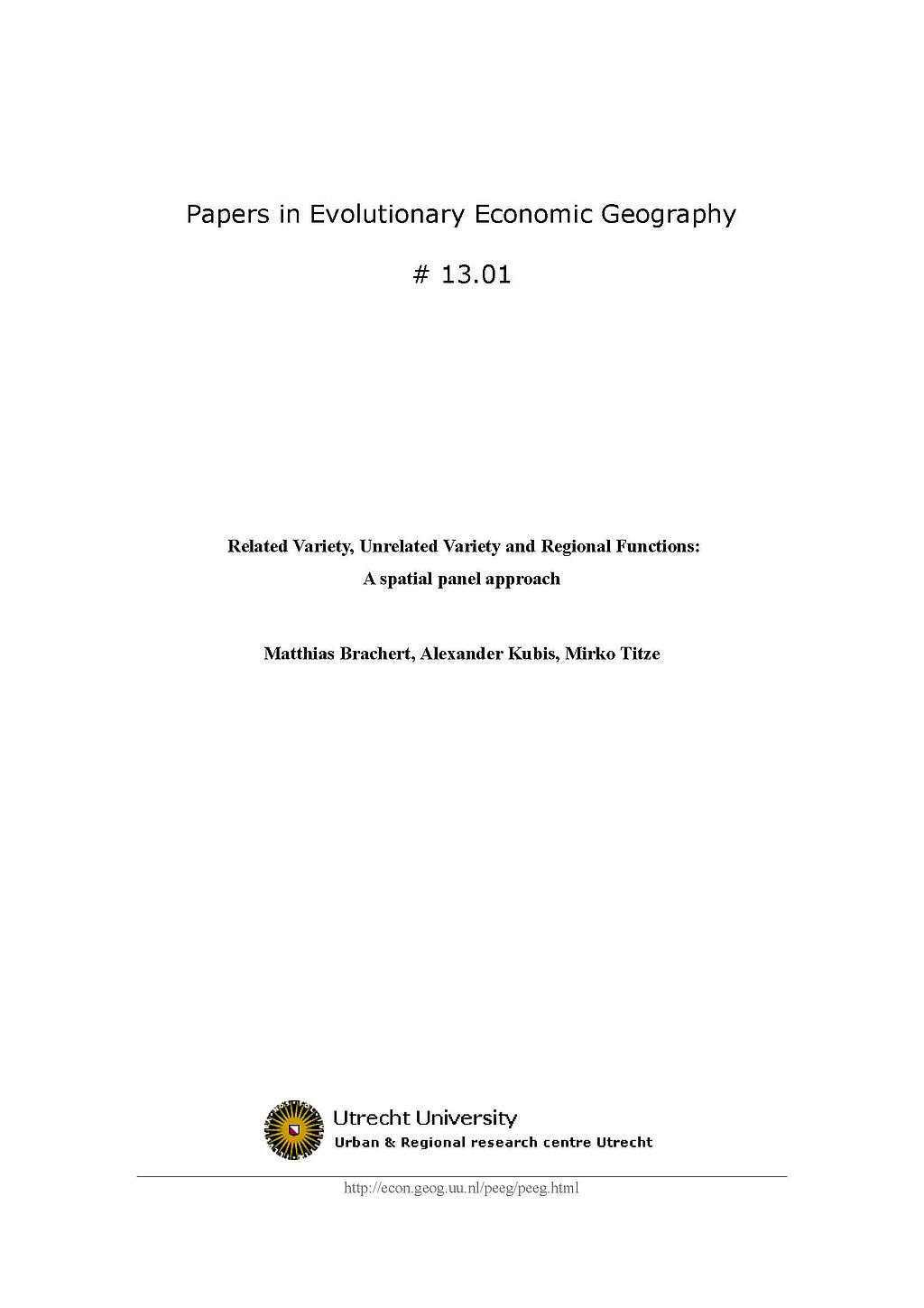
Related Variety, Unrelated Variety and Regional Functions: A spatial panel approach
in: Papers in Evolutionary Economic Geography, 2013
Abstract
The paper presents estimates for the impact of related variety, unrelated variety and the functions a region performs in the production process on regional employment growth in Germany. We argue that regions benefit from the existence of related activities that facilitate economic development. Thereby the sole reliance of the related and unrelated variety concept on standard industrial classifications (SIC) remains debatable. We offer estimations for establishing that conceptual progress can be made when the focus of analysis goes beyond solely considering industries. We develop an industry-function based approach of related and unrelated variety and test our hypothesis by the help of spatial panel approach. Our findings suggest that related variety as same as unrelated variety facilitate regional employment growth in Germany. However, the drivers behind these effects do differ. While the positive effect of related variety is driven by high degrees of relatedness in the regional “R&D” and “White-Collar”-functions, the effects of unrelated variety are spurred by “Blue Collar”-functions in this period.














